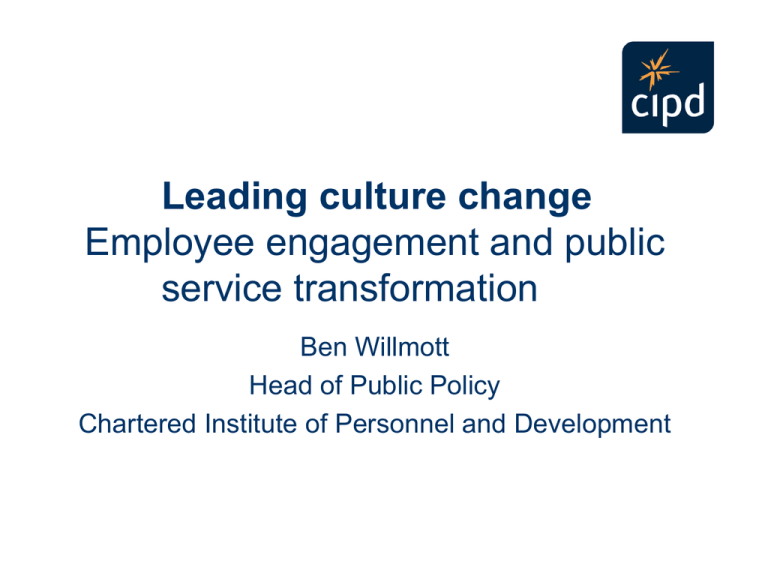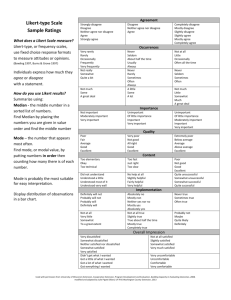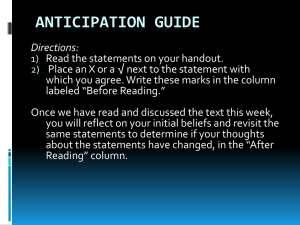Leading the Culture Change
advertisement

Leading culture change Employee engagement and public service transformation Ben Willmott Head of Public Policy Chartered Institute of Personnel and Development The research framework Engaging for success: enhancing performance through employee engagement The four broad enablers of employee engagement: • • • • Shared purpose/creating a strategic narrative Integrity Voice Engaging managers The service transformation challenge • “Services that are more local, more accountable and more personal, where people are the drivers not the passengers, which call on every part of society – from churches to charities, businesses to community organisations to come in and make a difference” , David Cameron 2011. The service transformation challenge • Achieving financial savings • Responding to the localism agenda • Growing demand for services Creating a strategic narrative • • • • • Articulating the vision Involving staff Selling a positive vision Responding to the localism agenda Local politics Customer-led service delivery • “It is almost like ripping up the council and starting again”, Richard Crouch, Director of HR and OD at Somerset County Council • The council has moved away from the old vertical directorate silos, centralised all business support, communication and marketing and split service commissioning from direct service delivery • It has created the role of Customer and communities director who informs strategy by providing customer insight through feedback from employees on the front-line and their customers Integrity – changing the culture • Culture – “how people behave in organisations when no one’s watching”, Bob Diamond, former Barclay CEO, 2011. • Public service transformation is about culture change • Organisational development • The role of HR • Employee engagement Engaging managers • Leadership starts at the top – leaders cast a long shadow • Values-based leadership a common theme • Distributed leadership key • We are all leaders now • HR’s role in developing leadership capability is crucial Employee attitudes to leaders (Employee outlook summer 2012) • Vision – 49% (36%) of employees agree their senior leaders have a clear vision; 23% (34%) disagree • Respect – Agree: 44% (33%); Disagree 29% (41%) • Confidence - Agree: 39% (26%) ;Disagree: 34% (49%) • Trust – Agree 40% (25%):Disagree 33% (53%) • Consult – Agree 28% (21%): Disagree 48% (57%) Leadership matters Correlation between positive attitudes towards senior managers and: • Lower frequency of exposure to excessive pressure • Higher scores to ONS subjective wellbeing questions • Employee engagement ‘Reality gap’ in the capability of UK plc’s 8 million people managers • Eight out of ten managers say they think their staff are satisfied or very satisfied with them as a manager whereas just 58% of employees report this is the case. • This ‘reality gap’ matters as the survey finds a very clear link between employees who say they are satisfied or very satisfied with their manager and those that are engaged • Six in ten (61%) of managers claim they meet each person they manage at least twice a month to talk about their workload, meeting objectives and other work-related issues. • However, just 24% of employees say they meet their managers with such frequency. What does engaging leadership look like? CIPD research highlights the management behaviours that underpin employee Engagement: • reviewing and guiding – including providing one to one support, help in prioritising tasks and working with staff to come up with new ideas • providing appropriate levels of autonomy and empowerment – this includes involving employees in problem-solving and decision making and acting as a coach when needed • taking an interest in the individual – this includes showing an interest in employees life outside work and the amount of pressure they are under • providing feedback, praise and recognition – this includes giving positive and negative feedback which is constructive and specific • having a personal manner – including having a positive approach to work, showing enthusiasm and being approachable Closing the knowing-doing gap • OD and leadership development activities must be mutually reinforcing • ‘The nature of ‘followership’ also has to change • How managers are recruited, developed, promoted and performance managed is critical • Some people should never manage other people • Management capability audit - data is key – from manager appraisals, 360 degree feedback, staff survey results • What combination of learning interventions actually embed behaviour change? Leadership development Evidence base is poor but suggests that three areas are important: • Leader identity • Authenticity • Learning orientation Voice • “People are not struggling with the broad concepts set out by Delivering the Smarter council; it is the how we are going to do it that we have got to concentrate on…Engagement with staff will enable us to continue the conversation organisationally about ‘the how’ in order that we can then produce the means of doing it.” Niall Bolger, CEO Sutton Council Voice • Visibility and accessibility of senior leaders • Building trust by listening and acting on the small issues • Wide range of arrangements for listening to and considering the views of staff • Relationships with the unions generally remain positive Conclusions • Leadership is high on CEO’s agenda • HR is at the heart of the transformation process • The wider political context has significant influence on the transformation process • The gap between the political and executive leadership of local authorities and police forces in particular has narrowed in some instances • Improving the communication process is regarded as a priority • There is a need to develop a new psychological contract or employee value proposition











